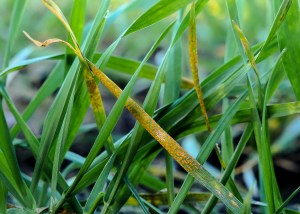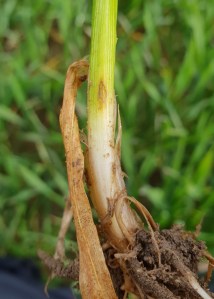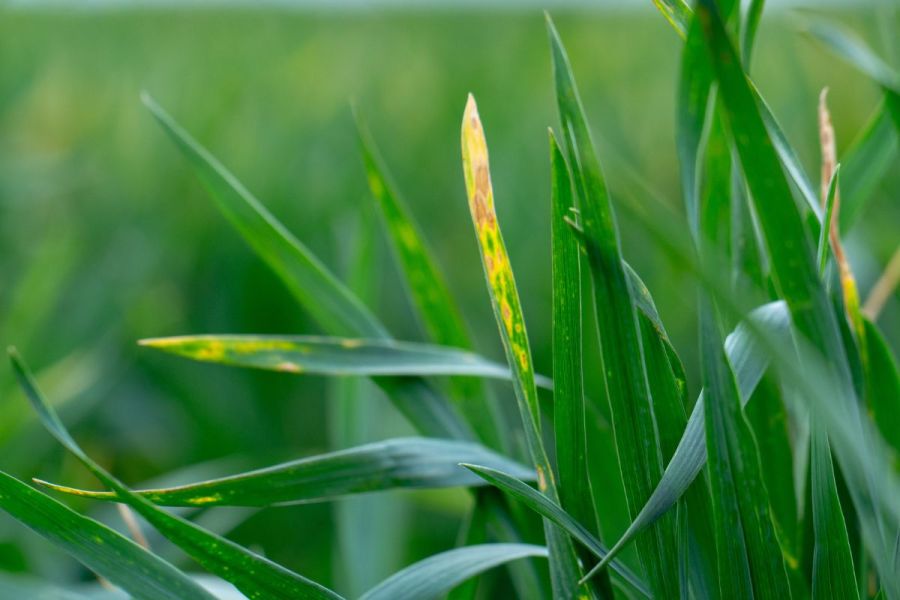A relatively warm and dry February saw field work resume in earnest. With yellow rust already at uncomfortable levels in some regions and the T0 timing on the horizon, CPM gathers thoughts on disease control at a roundtable event hosted by Bayer.
“It’s a common misconception that the RL rating for yellow rust is representative of the whole season, but we don’t actually know when adult plant resistance will kick in.”
By Lucy de la Pasture
Every season produces its unique challenges when it comes to controlling cereal diseases. With fungicide prices following the agflation curve and belts tightening on input spend, making the best decisions has never been more important when it comes to maintaining a healthy crop and a healthy bottom line.
With the goalposts always moving when it comes to diseases, changes in establishment practice, weather, varieties and chemistry mean that a change in approach may be required, says Bayer’s Greg Hanna

Although more resistant varieties are proving popular with growers, John Miles warns that the trend towards earlier drilling puts the pressure back on even resistant varieties.
There’s no argument around the table that variety choice remains fundamentally important as part of an integrated strategy for managing diseases – the days of reliance on a fungicide as a cure all are well and truly over. According to Agrii’s John Miles, the profile of varieties in the ground has changed as a result over the past two decades, with the monsoon summer of 2012 standing out as ‘the watershed year’.
“Before 2012, varieties with a septoria rating of 6 or less were widespread [in terms of the % of overall winter wheat in the ground]. But thereafter the balance began to change and by 2023, we’re seeing a much more balanced spread of uptake.”
Looking at the NIAB data for commercial seed sales for the 2023 crop, John notes that some of the less resistant varieties still have a reasonable market share, with Skyfall at 6%, Gleam 7% and Skyscraper 9.6%. But topping the Agrii charts is the disease resistant allrounder, KWS Dawsum, at 16%, closely followed by the ever-popular septoria resistant variety, KWS Extase at 14.4%. Also making the top 10 varieties is old faithful Graham (7.1%) and Champion (6.9%).
But although those more resistant varieties are proving popular with growers, John also warns that the trend towards earlier drilling – particularly where blackgrass isn’t a concern and in direct drilling situations, where there’s no time waiting for cultivations to be done ahead of the drill – puts the pressure back on. September drilling effectively knocks a point off a varieties septoria resistance rating and that’s a risk going into the spring.
It’s something to be aware of this year, he highlights. “There was an early finish to harvest in 2022 and many people just cracked on. I’ve just been up in the Borders and some wheat went in during August and September. The septoria situation is looking very exciting up there,” he says.

Use of prothioconazole-containing fungicides at T1 has indirectly been targeting eyespot but the trend for cutting back at this timing may be opening a hidden back door for the disease, says David Boulton.
For independent agronomist and AICC member, David Boulton of Indigro, drilling dates were spread from 10 September to 10 November. “Growers with blackgrass have the mindset to wait until the second or third week of October but others are shifting drilling dates forwards to balance a bit of risk and they’re managing that risk by going earlier on fields that are relatively clean where grassweeds are concerned,” he says.
David suspects that the recent bolstering of herbicide options for grassweed control may also have led some growers to put more reliance on chemical rather than cultural control methods for blackgrass. “We have Luximo (cimethylin) and Proclus (aclonifen) at the moment, so some people are comfortable to move drilling forward by seven days or so.”
Greg believes the wet autumn of 2019 is still at the back of many growers’ minds – there was no opportunity to plant wheat past September that year. “With weather patterns becoming more and more unpredictable, if the weather breaks there may not be another opportunity to get the crop in so they get on when they can.”
NIAB’s Dr Aoife O’Driscoll picks up on the effect climate variability is having on varieties later in the season, with consequent effects on leaf layer emergence as well as the prevalence of ear diseases, such as ergot and fusarium species.
“We have a lot of later maturing varieties on the AHDB Recommended List now and, in some areas, where May has been cool and damp this can lead to a protracted flowering period, often with differences in anthesis across the field which favours these diseases.”
Grass margins and uncontrolled grassweeds within the crop, including blackgrass, meadow brome and various ryegrass species also provide a host to ergot, notes Aoife. “When thinking about how ergot got into the crop or how it is spread, a useful exercise would be to walk grass margins in late April to assess whether there are ergots present.”
Another rumbling threat, that all around the table have noticed increasing in crops in recent years, is eyespot. Once a disease that was high on an agronomist’s watch list, eyespot has become less of a priority than it used to be because available chemistry has been good at controlling it.
Aoife believes that eyespot may have become more noticeable of late because of weather conditions favouring its development and she reckons that any change in prevalence could be having an effect on how varieties are being rated on the RL. But she points out that we really don’t know whether the disease itself has changed in response to the changing climate.
“Eyespot is one of the diseases where there is a lack of any recent epidemiology studies,” she notes.
John agrees that eyespot is being picked up more often in Agrii trials and he says there have been some control issues due to boscalid no longer being used at T1 and prothioconazole rates being trimmed. “It could be a potential pitfall going forwards but it’s not a high breeding priority, so eyespot may come back to bite us.”
David says use of Aviator Xpro (bixafen+ prothioconazole) or Ascra Xpro (bixafen+ fluopyram+ prothioconazole) has indirectly been targeting eyespot at the T1 timing and agrees the trend for cutting back at this timing may be opening a hidden back door for the disease.
NIAB have done numerous trials looking at the value of applying a fungicide at T1 in low risk varieties in perceived low risk situations, says Aoife. “There’s always a value in putting something on, even if it’s just a folpet and tebuconazole mix. But if using folpet we have observed the benefits come from an all or nothing approach. If you’re going to use it, a full-rate at T1 and T2 gives the best result.”
David reckons folpet gives a return on investment just 50% of the time on his farms but being a multi-site, there’s a good argument for including it for resistance management, he says, agreeing with Aoife’s all or nothing approach.

With yellow rust, you have to treat what’s in front of you rather than rely on resistance genes to kick in.
In recent seasons, it’s yellow rust that has taken on the mantle of being the most troublesome disease in wheat. No one doubts the impact that septoria can have on yield but lately weather patterns have favoured the development of rusts.
David comments that with 35-45% of varieties in the ground highly susceptible to yellow rust, and inoculum ‘enormous’, that it’s brewing up to be a problem this spring. For the most susceptible varieties, such as KWS Zyatt and Gleam, he expects to be looking at the leaf layers and treating for yellow rust as they emerge.
“Yellow rust has come in early in the East and is quite severe in places already. In Scotland, yellow rust is there in quite some levels. Even in the West, rusts are occurring more frequently,” adds John.
There’s agreement around the table that it’s time to move away from septoria in the West, yellow rust in the East stereotyping – everything is everywhere.
On the more positive side, according to the UK Cereal Pathogen Virulence Survey (UKCPVS) there haven’t been any major changes in yellow rust virulence and pathogen populations are relatively stable, says Aoife.

Aoife O’Driscoll picks up on the effect climate variability is having on varieties later in the season, with consequent effects on leaf layer emergence as well as the prevalence of ear diseases, such as ergot and fusarium species.
“But we are lacking up-to-date research on the biology and behaviour of the disease on-farm, with the most recent study carried out by Dr Pete Gladders and colleagues in 2007. The biology may or may not have changed in this time but from this study, a minimum of five days of air frost at minus 5⁰C is required to knock back any yellow rust which might have penetrated leaf tissues and is ready to reproduce. So have we had that this winter?’’
In spite of cold spells during December and January, none of the agronomists are confident it has been cold enough for long enough to keep a lid on yellow rust. All agree that when you have a yellow rust infection in the crop, you have to treat it according to what’s in front of you rather than go by its RL resistance rating.
“It’s a common misconception that the RL rating for yellow rust is representative of the whole season, but we don’t actually know when adult plant resistance will kick in,” says John.
Aoife says John’s comment reflects a dichotomy within the industry when it comes to RL ratings. “If you’ve got yellow rust then economically you have to crack on and treat it, you can’t afford to sit and watch the crop hoping adult plant resistance will kick in.”
John notes that putting aside any septoria resistance issues, the Cougar lineage provides a good source of yellow rust resistance. “We also need to be aware of the amount of Timaru material coming through in breeding lines. We’ve had KWS Siskin and Costello but now KWS Palladium, KWS Ultimatum, KWS Cranium and KWS Dawsum are potentially relying on a similar resistance package.”
David notes that there’s quite a lot of Reflection in some wheat lineages too – a variety that broke spectacularly under the strain of yellow rust. John agrees that no Refection genes can bring yellow rust resistance into a cross, but the outcome can still be good if the other parent offers genetic diversity, as is the case with Champion. He also highlights that where a variety has good yellow rust resistance, the opposite is normally the case when it comes to brown rust.
The variety that immediately comes to mind when brown rust is mentioned is Crusoe, notes David, and it’s a variety that’s proving popular with growers because of its superior nitrogen use efficiency. But there are several popular varieties that are susceptible and both John and David believe the role of fungicides in improving NUE is often overlooked.

Many varieties on the RL have a weakness to eyespot, so the disease may assume more importance where early disease control is skipped or where fungicides which don’t pick up eyespot are applied.
“If you want to maximise NUE then it’s by optimising yield that you can achieve that. There’s a narrative to reduce inputs across the board but by taking that approach, there’s a danger you’ll allow yield to erode. It’s just as important to make good product choices and apply them at the right disease control and nutritional timings. Good farming practice leads you to a better NUE,” says John.
There are also hidden advantages to some fungicide products, adds Greg. “The bixafen component in Ascra increase N-reductase, improving availability.”
It’s an effect John has seen in Agrii Green Horizons trials with Boogie Xpro Plus (prothioconazole + bixafen+ spiroxamine). “We’ve seen an improved NUE where Boogie Plus has been used and it also seems to help more micronutrients get into the plant. It’s making everything work harder.
“In stressful, cool and dry springs – as soon as soil moisture disappears, bang goes the availability of micro- and macronutrients. It focuses a light on how important the little things can be, a nutritionally balanced plant is much better able to cope with stress,” he says.
Going back to fungicide timings, there’s a broad agreement that SDHIs bring advantages at the T1 timing. In spite of the newer fungicide chemistry that’s now available, David feels that Ascra still answers the questions at T1. “It covers all the diseases of concern at leaf three emerged, without spending too much money and has the advantage of rate flexibility.”
It’s a strategy Aoife supports for low to moderate septoria risk varieties in a low to moderate disease scenario. In moderate to higher risk varieties under moderate to high disease pressure then she suggests moving to a programme utilising Revystar XE (mefentrifluconaze+ fluxapyroxad) at T1, followed by Univoq (prothioconazole+ fenpicoxamid) at T2.
In situations where septoria pressure comes in late season, the use of Univoq at T2 opens up the possibility of using an SDHI at T3, adds John, which could be a less risky strategy than not applying an SDHI at T1.
Summing up, John says that the way farming is being enacted has completely changed in recent years and it follows through that decision-making will change too. Aoife points to the uptake of SFIs, adoption of green margins, cover crops and direct drilling as examples of factors which will provide new challenges that we may not yet fully understand.
“Grasses act as alternate hosts for some cereal diseases. Could it be a ticking time bomb?” she asks.
BYDV is another concern, says John. “We’re already seeing more BYDV in some places. No one looks for aphids in cover crops.”
With growers now being incentivised not to use insecticides under one of the SFI options, there’s going to need to be a rebalancing of the system while beneficials build up, comments David.
Now’s a good time to go back to basics, concludes Aoife. “There’s a lot of ‘noise’ out there at the moment to cut through, but don’t forget the basics. We have to understand the biology of diseases to manage them.”
This article was taken from the latest issue of CPM. For more articles like this, subscribe here.
Sign up for Crop Production Magazine’s FREE e-newsletter here.




